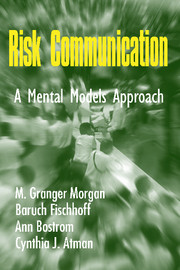Book contents
- Frontmatter
- Contents
- Preface
- Risk Communication
- 1 INTRODUCTION
- 2 OUR MENTAL MODELS APPROACH
- 3 CREATING AN EXPERT MODEL OF THE RISK
- 4 MENTAL MODELS INTERVIEWS
- 5 CONFIRMATORY QUESTIONNAIRES
- 6 DEVELOPMENT AND EVALUATION OF COMMUNICATIONS
- 7 CASE STUDIES: APPLICATIONS TO ENVIRONMENTAL RISKS
- 8 A MENTAL MODELS APPROACH TO HIV/AIDS
- 9 SOME CONCLUDING THOUGHTS
- Appendix A Brochure on global warming and climate change
- Appendix B Brochure on fields from electric power
- Appendix C Risk communication materials on HIV/AIDS
- Appendix D Sample transcripts of mental model interviews
- Index
6 - DEVELOPMENT AND EVALUATION OF COMMUNICATIONS
Published online by Cambridge University Press: 05 June 2012
- Frontmatter
- Contents
- Preface
- Risk Communication
- 1 INTRODUCTION
- 2 OUR MENTAL MODELS APPROACH
- 3 CREATING AN EXPERT MODEL OF THE RISK
- 4 MENTAL MODELS INTERVIEWS
- 5 CONFIRMATORY QUESTIONNAIRES
- 6 DEVELOPMENT AND EVALUATION OF COMMUNICATIONS
- 7 CASE STUDIES: APPLICATIONS TO ENVIRONMENTAL RISKS
- 8 A MENTAL MODELS APPROACH TO HIV/AIDS
- 9 SOME CONCLUDING THOUGHTS
- Appendix A Brochure on global warming and climate change
- Appendix B Brochure on fields from electric power
- Appendix C Risk communication materials on HIV/AIDS
- Appendix D Sample transcripts of mental model interviews
- Index
Summary
Principles
The mental models interviews and follow-up questionnaires typically identify many more misconceptions and gaps in lay knowledge than one can hope to address or fill with a risk communication of modest length. As a result, the first stage in developing a communication is to set priorities. If one had a fully computational expert model and a full set of parameter estimates, then one could compute the impact of providing different pieces of missing information. Specifically, one could compute the percentage of people whose decisions would change as a result of providing each piece of information (Fischhoff, Bostrom, and Quadrel, 1997; Fischhoff, Downs, and Bruine de Bruin, 1998; Merz et al., 1993; Riley, 1998).
Here, we will focus on more heuristic methods. However, the logic is the same. Communications should focus on the facts that will have the greatest impact on the greatest portion of the audience. There is little point in emphasizing a central fact in the expert model if audience members know it already – unless repeating that fact helps to tell a more coherent, memorable, and understandable story. Nor is there much point in filling a common gap if knowing that fact would not change people's overall judgments or actions.
This chapter begins by describing the choices we made in designing our communications regarding radon (Section 6.1.2). It proceeds to general procedures for building messages (6.2). It then offers methods for the evaluation that should be part of any developmental process (6.3), including technical review (6.4), text-based evaluation (6.5), and reader-based evaluation (6.6).
Information
- Type
- Chapter
- Information
- Risk CommunicationA Mental Models Approach, pp. 97 - 124Publisher: Cambridge University PressPrint publication year: 2001
